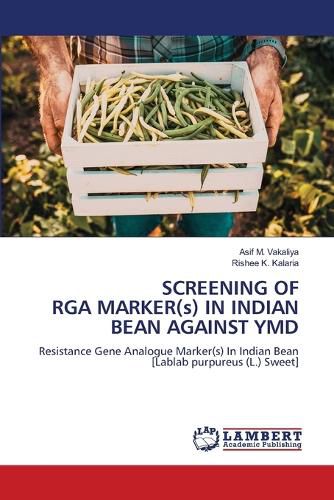Readings Newsletter
Become a Readings Member to make your shopping experience even easier.
Sign in or sign up for free!
You’re not far away from qualifying for FREE standard shipping within Australia
You’ve qualified for FREE standard shipping within Australia
The cart is loading…






This title is printed to order. This book may have been self-published. If so, we cannot guarantee the quality of the content. In the main most books will have gone through the editing process however some may not. We therefore suggest that you be aware of this before ordering this book. If in doubt check either the author or publisher’s details as we are unable to accept any returns unless they are faulty. Please contact us if you have any questions.
In present investigation six resistant (P-19- 169, V-19-15, V-19-35, GNIB-22, W-19-05, V-19-24) and six highly susceptible (P-19-176, W-19- 60, P-19-127, V-19-11, W-19-58, V-19-106) Indian bean genotypes were screened by nine pairs of RGA primers. Seven pairs of RGA primers were successfully amplified as a result of this in all resistant genotypes, but not in all highly susceptible genotypes. The amplicons were obtained in seven pairs of RGA primers, where five pairs of RGA primersRGA1FCG &RGA1R, VMYR1F & VMYR1R, YR4F & YR4R, RGAIB3 & RGAIB4, RGAIB5 & RGAIB6 amplified single band size of approximately 450 bp, 450 bp, 450 bp, 450 bp and 1050 bp respectively in resistant genotypes, while only two pairs of RGA primers CYR1F & CYR1R and RGAIB1 & RGAIB2 were found with prominent band of approximately 950bp and 350bp. According to the data from the current investigation, seven pairs of RGA markers have proven successful in differentiating between the resistant and highly susceptible genotypes of Indian beans. These RGA markers can be employed in investigations mapping resistance genes and validating markers with long-lasting YMV resistance.
$9.00 standard shipping within Australia
FREE standard shipping within Australia for orders over $100.00
Express & International shipping calculated at checkout
Stock availability can be subject to change without notice. We recommend calling the shop or contacting our online team to check availability of low stock items. Please see our Shopping Online page for more details.
This title is printed to order. This book may have been self-published. If so, we cannot guarantee the quality of the content. In the main most books will have gone through the editing process however some may not. We therefore suggest that you be aware of this before ordering this book. If in doubt check either the author or publisher’s details as we are unable to accept any returns unless they are faulty. Please contact us if you have any questions.
In present investigation six resistant (P-19- 169, V-19-15, V-19-35, GNIB-22, W-19-05, V-19-24) and six highly susceptible (P-19-176, W-19- 60, P-19-127, V-19-11, W-19-58, V-19-106) Indian bean genotypes were screened by nine pairs of RGA primers. Seven pairs of RGA primers were successfully amplified as a result of this in all resistant genotypes, but not in all highly susceptible genotypes. The amplicons were obtained in seven pairs of RGA primers, where five pairs of RGA primersRGA1FCG &RGA1R, VMYR1F & VMYR1R, YR4F & YR4R, RGAIB3 & RGAIB4, RGAIB5 & RGAIB6 amplified single band size of approximately 450 bp, 450 bp, 450 bp, 450 bp and 1050 bp respectively in resistant genotypes, while only two pairs of RGA primers CYR1F & CYR1R and RGAIB1 & RGAIB2 were found with prominent band of approximately 950bp and 350bp. According to the data from the current investigation, seven pairs of RGA markers have proven successful in differentiating between the resistant and highly susceptible genotypes of Indian beans. These RGA markers can be employed in investigations mapping resistance genes and validating markers with long-lasting YMV resistance.